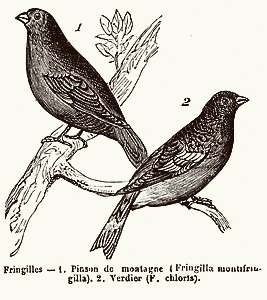Fringilla

FRINGILLA: (lat. fringilla, finch). Ornith. Name given by Linné to a large genus of the order insessores, sub-order oscines, tribe conirostres, family fringillidae, which includes a large category of small birds with bright colors and a thick and more or less conical short bill. The waxbill, (estrilda, Linn.), is approximately 16 inches long; its bill is bright red, like its chest; its general color is brown on the back and a reddish gray on the belly, with dark wavy patterns. This charming bird lives in Africa, from Senegal to the Cape of Good Hope.
– The Java finch, commonly called Java sparrow, (amadina oryzivora, Linn.), padda, or Java rice bird, is approximately 4 inches long; its bill is strong and red, its eyelids are of the same color, its head and its throat are black, the sides of its head under the eyes are white, its back is ash-colored, its belly and its thighs are of a pale pink color; its behind is white, its tail black; it lives in Java, China and India.
– To the fringilla group belong the finches, weavers, indigo-birds and whydahs, linnets, goldfinches, canaries, siskins, hawfinches, buntings, bullfinches, crossbills, etc. These birds are widespread all over the world, and live in troops, among which other species are often included. Their food consists of seeds in the winter; of larvae, worms and grain in the summer. More than 80 species have been described. The brambling (fringilla montifringilla, Linn.) is approximately 5.5 inches long. It lives in Great Britain in the winter, disappears at the end of spring and moves up North where the laying takes place; it is strong and bold, it feeds on seeds and on whatever it can collect in the fields; its flight is fast. The greenfinch (fringilla chloris, Linn.), a european species, is approximately 5.5 inches long and has a wingspan of 7.8 inches; its bill is very strong, its tail is short and its body large. It is indigenous and does not emigrate; it is sturdy, friendly, tractable and lives in group. When caged, it emulates the call of the other birds; its own consists of three or four short and melodious notes. The pine finch (fringilla pinus Wils.; chrysomitris, Boie) can be found in North America, from the Atlantic to the Pacific coast. Its flight and its call are like those of the goldfinch; like the latter, it cleaves through the air, flying in long and gracious curves.
– The american fringillae form the genus zonotrichia (Swains), they are commonly called finches; their bill is perfectly conical, their wings are of poor size, their tail is long and broad. The grass finch (zonotrichia raminea, Gmel.; genus of poocœtes, Baird) can be found in the north of the United States from the Atlantic to the Pacific coast; its singing is soft and long-winded; it is a shy and solitary bird, which runs through the grass, where it builds its nest; its food consists of various kinds of seeds and insects and its flesh is tender and tasty. The north american Lincoln sparrow (zonotrichia Lincolnii, Aud.; melospiza, Baird) makes a very soft and ringing sound; its flight is fast and low, its food consists of insects and berries; males, like nearly all finches, are quarrelsome.
– The genus ammodromus (Swains.) is characterized by short wings, long tail, side feathers with a pointed tip; its species include birds which usually live on shores, run in the grass on the coast, climb reeds, or spring quickly among grass tufts; they eat shrimps, small molluscs, small shellfish and other sea animals. The sharp-tailed sparrow (Ammodromus caudacutus, Gmel.) can be found all over the Atlantic coast of the United States and in abundance in the salt-marshes of South Carolina.
– Among the spiza genus (Bonap.) or cyanospiza (Baird), the wings and tail are of average size. The painted bunting (spiza ciris, Bonap.) lives in Texas and Mexico; its flight is short and fast; its call is ringing and pleasant. In the past, a great number of these gorgeous birds were taken to Europe, where they cost nearly fabulous prices; one of them bought 8 pennies in New-Orleans, was sold for 8 pounds in London.
Extract from the Trousset encyclopedia, 1886 – 1891.
Tags: animals, birds, finches, fringilla, ornithology, Trousset encyclopedia


